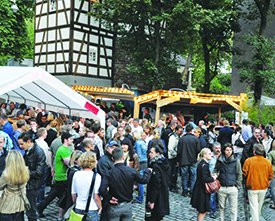By Carola Meusel
USAG Stuttgart Public Affairs Office
Stuttgart takes great pride in its annual fests and cultural outings. Locals and visitors alike find themselves confronted with endless opportunities for outdoor fests and “must do” happenings, especially during the summer months.
Almost every fest celebrates a historic event, anecdote or tradition, as does the “Bohnenviertelfest,” or Bean Quarter Fest, that is held toward the end of July in downtown Stuttgart.

The Bean Quarter was founded in the 15th century and was one of Stuttgart’s first housing areas to be built outside the city fortification. The quarter was mainly occupied by the city’s poorer residents, such as craftsmen and vintners, who worked there as well.
The name “Bohnenviertel,” or Bean Quarter, originates in the fact that most of its residents grew pole beans and vegetables in their gardens to feed their families. For years, the residents knotted beans on strings so that they grew like garlands around the housing facades.
When Württemberg’s crown prince Karl was born in 1823, residents of the Bohnenviertel announced: “Erbse, Bohne, Linse: Hurra, mer hent en Prinze!” which translates to: Peas, beans, lentils — hurray, we have a prince!”
In the 19th century, vendors, craftsmen and day laborers settled in the quarter. Flower, vegetable, jewelry, antique shops and restaurants opened, setting ground for the neighborhood’s eclectic atmosphere.
The Bohnenviertel even played a part in the development of the automobile. According to Monika Kurfess of the “Handels- und Gewerbeverein Bohnenviertel,” a business association of all vendors in the quarter, the “body” for the first automobile came from the Bohnenviertel. While it’s common knowledge that Gottlieb Daimler invented and built the first gas engine in Bad Cannstatt, in 1886, the Bean Quarter’s Wilhelm Wimpff factory supplied him with a horse carriage that he later converted into the first four-wheeled automobile. According to the “Geschichte des Bohnenviertels,” or history of the Bean Quarter information paper, people who lived in the Bean Quarter were described by fellow Stuttgart residents as “unique” and “eccentric.”
Today, the quarter, which is the only originally preserved part of Stuttgart’s historic downtown area, still sticks to this motto and features small, unique stores, arts and crafts, restaurants, bars and coffee shops, according to Kurfess.
“It’s the charm of this historic quarter that makes it so very special,” Kurfess said during an earlier interview. “Everything here is smaller and a little different.”
Visitors to the Bean Quarter will find furniture, interior decorations, antiques, jewelry, books, galleries, arts and crafts, as well as traditional Swabian wine restaurants, Italian, Greek, Russian and Asian cuisine and specialty stores.
The tradition of the Bohnenviertelfest dates back to 1991, when local merchants decided to form a business association to reestablish the quarter’s historic heritage. Ever since, on the last weekend in July, patrons crowd the streets and alleys of the Bohnenviertel for the annual outing. During the street festival, visitors have the chance to tour and explore the Bean Quarter’s cobblestone streets, hidden alleys and timbered houses. According to Kurfess, patrons can also stroll through the shops and even take a glimpse into a studio or production hall of an interior designer.
“The fest is like an open house for all our visitors, and they have the chance to look behind the scenes exclusively during the event,” Kurfess said.
Most stores are open all evening throughout the three days of the event. Regional bands and musicians will entertain the crowds with rock, pop, jazz, funk, soul and folk tunes.
A children’s program with arts and crafts and face painting will be offered as well.
Visitors can also indulge in Swabian, African, Greek, Italian, Croatian and Asian foods, as well as in local wines, summer cocktails, chocolate-covered fruits and homemade cakes. “Visitors to the Bean Quarter are invited to simply enjoy their time at the fest. They can take in the historic charm, shop, eat, drink, listen to music and simply have a good time,” Kurfess said.
The fest begins July 21 at 5 p.m., July 22 at 6 p.m. and July 23 at 1 p.m. The fest will be open until midnight on all three days.
The Bean Quarter is located between the “Charlottenplatz” and “Leonhardsplatz” squares.
For more information, visit www.das-bohnenviertelfest.net or www.bohnenviertel-stuttgart.de.
Sources: “Geschichte Bohnenviertel und Pfarrstrasse
